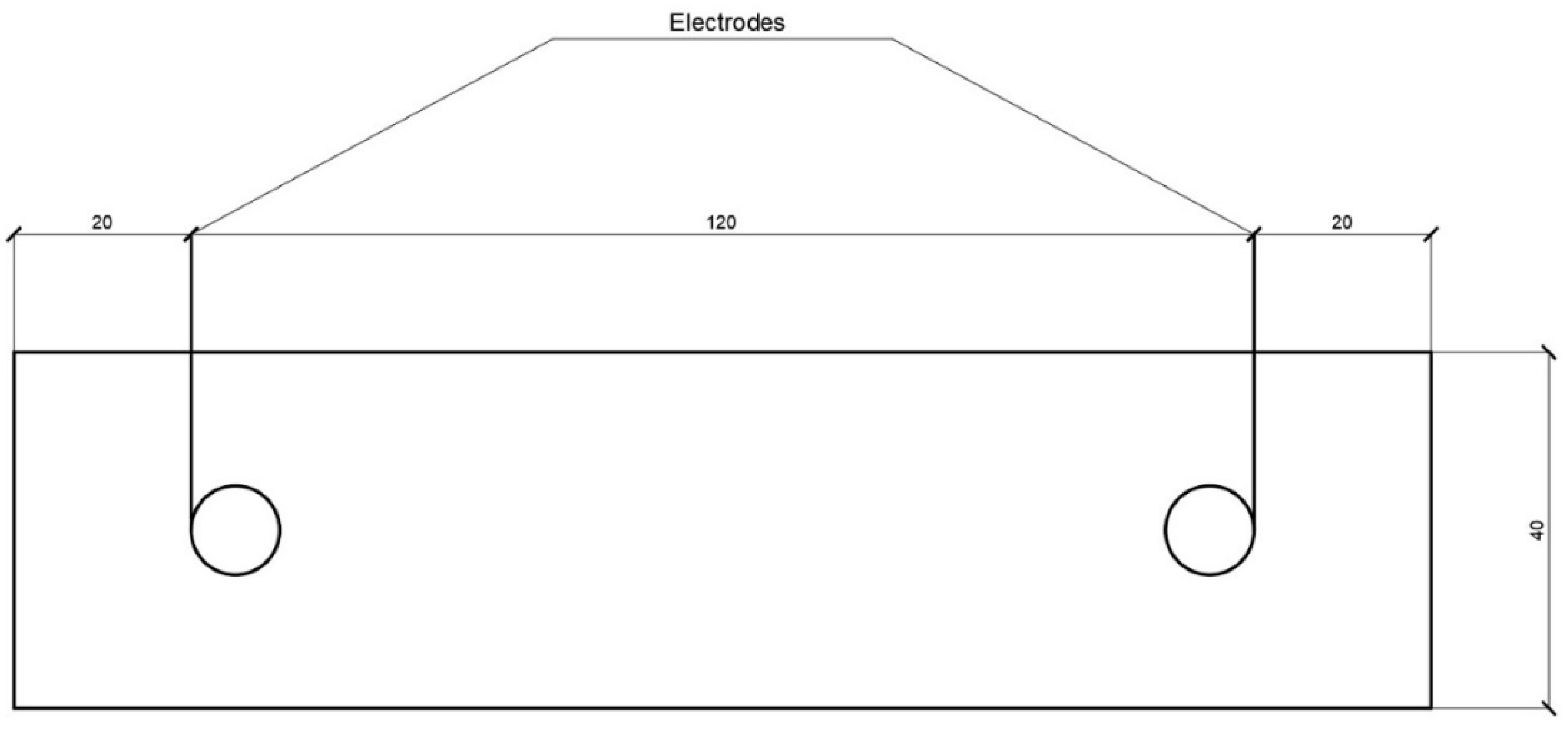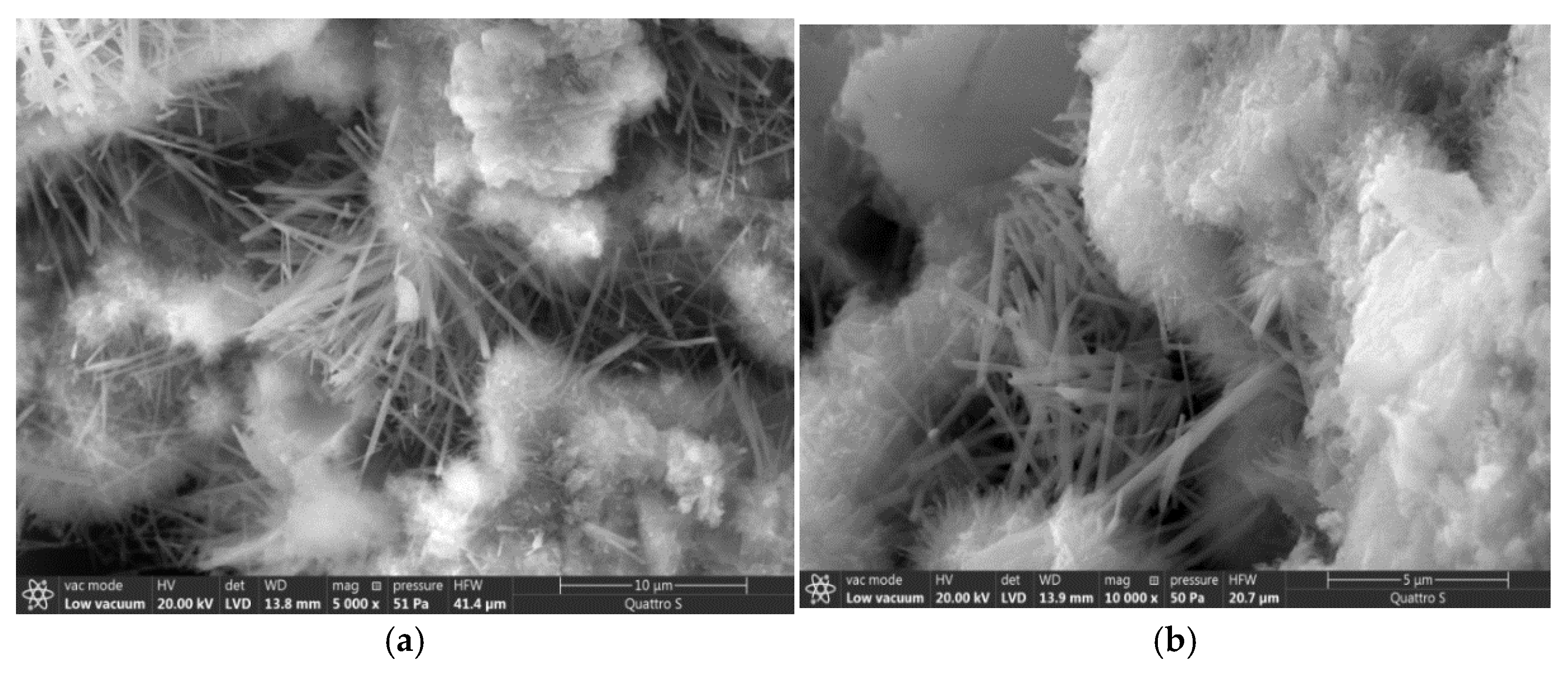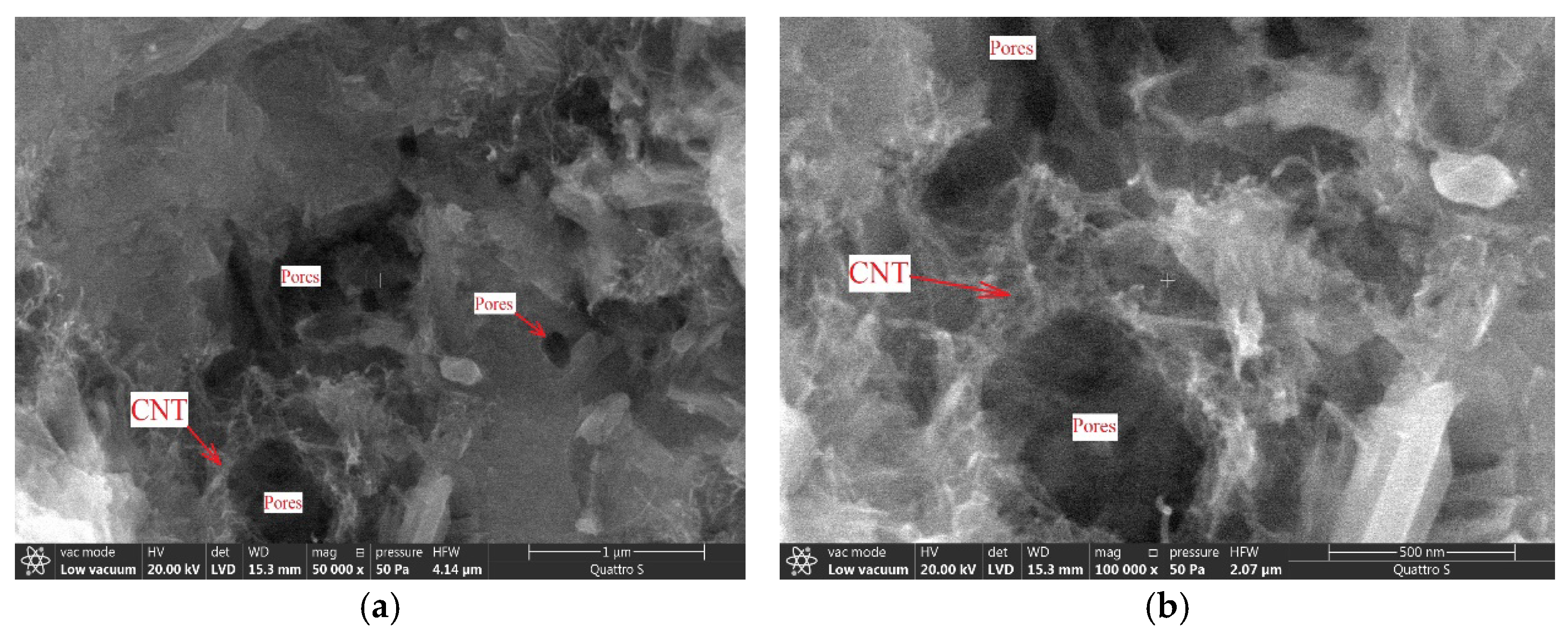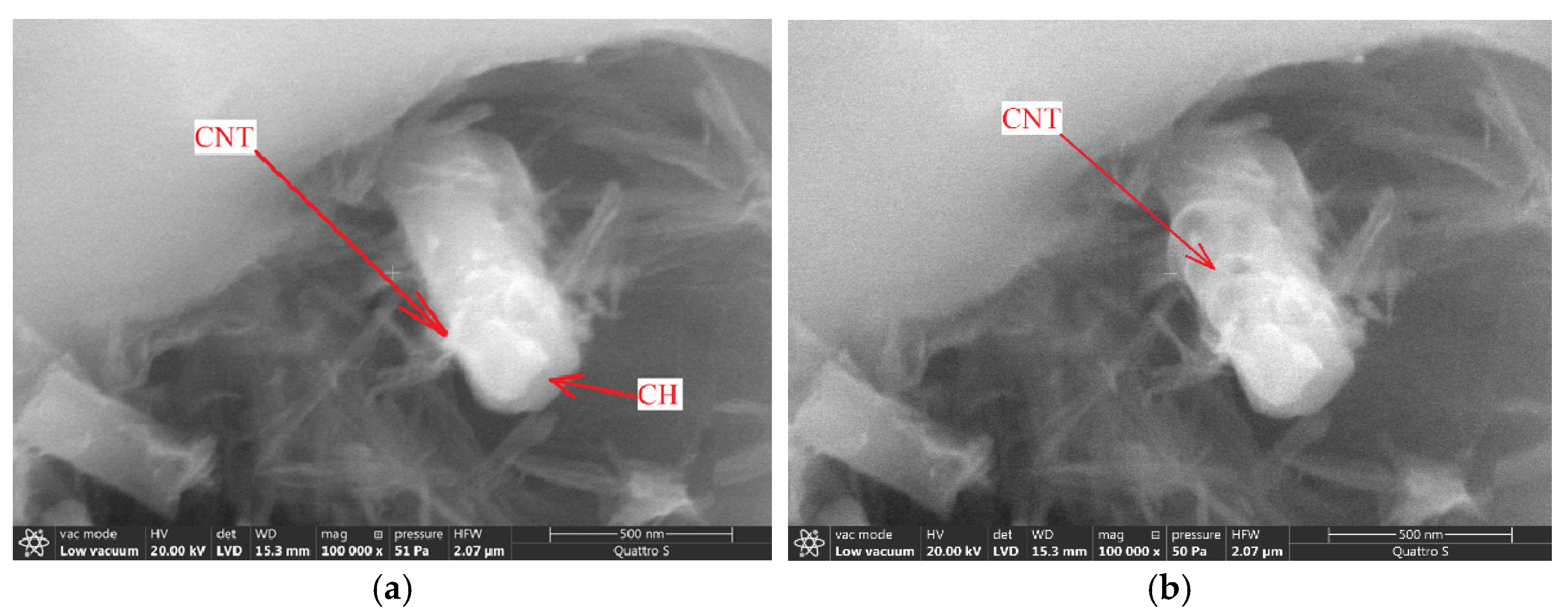The Effect of Complex Modification on the Impedance of Cement Matrices
Abstract
:1. Introduction
2. Materials and Methods
3. Results
4. Conclusions
- -
- the slight decrease of compressive strength is observed when using multilayer carbon nanotubes in the amount of 7% as an impedance-reducing modifier; at the same time the decrease of electrical resistance of samples was 12% at the age of 28 days of hardening compared to the control additive-free sample;
- -
- the increase of the electrical conductivity of the composition with 7% of carbon nanotubes should be noted in the period of structure formation from 3 to 28 days due to changes in the morphology of hydration products. The influence of microstructure features on the electrical conductivity of the cement matrix should be indicated since amorphous hydration products in the control sample determine the unsatisfactory electrical properties;
- -
- the positive effect of the complex modification with calcium nitrate and carbon nanotubes has been determined. It consists of sufficient strength characteristics while reducing the electrical resistance. The composition with the content of 7% carbon nanotubes in combination with 3% calcium nitrate ensures the compressive strength of 28 MPa and the electrical conductivity of 2440 Ohm.
Author Contributions
Funding
Institutional Review Board Statement
Informed Consent Statement
Data Availability Statement
Acknowledgments
Conflicts of Interest
References
- Cruz, A.M.; Javier, P. Self-compacted concrete with self-protection and self-sensing functionality for energy infrastructures. Materials 2020, 13, 1106. [Google Scholar] [CrossRef] [PubMed] [Green Version]
- Rovnaník, P.; Kusák, I.; Bayer, P.; Schmid, P.; Fiala, L. Electrical and Self-Sensing Properties of Alkali-Activated Slag Composite with Graphite Filler. Materials 2019, 12, 1616. [Google Scholar] [CrossRef] [Green Version]
- Hong, S.-H.; Yuan, T.-F.; Choi, J.-S.; Yoon, Y.-S. Effects of Steelmaking Slag and Moisture on Electrical Properties of Concrete. Materials 2020, 13, 2675. [Google Scholar] [CrossRef]
- Anwar, M.S.; Suitha, B.; Vedalakshmi, R. Light-weight cementitious anode for impressed current cathodic protection of steel reinforced concrete application. Constr. Build. Mater. 2014, 71, 167–180. [Google Scholar] [CrossRef]
- Bernatskii, A.F.; Tselebrovskii, I.U.N.; Chunchin, V.A. Electrical Properties of Concrete; Moscow Energiya: Moscow, Russia, 1980; p. 208. [Google Scholar]
- Sassani, A.; Ceylan, H.; Kim, S.; Arabzadeh, A.; Taylor, P.; Gopalakrishnan, K. Development of Carbon Fiber-modified Electrically Conductive Concrete for Implementation in Des Moines International Airport. Case Stud. Constr. Mater. 2018, 8, 277–291. [Google Scholar] [CrossRef]
- Wu, J.; Liu, J.; Yang, F. Three-phase composite conductive concrete for pavement deicing. Constr. Build. Mater. 2015, 75, 129–135. [Google Scholar] [CrossRef]
- Sandrolini, L.; Reggiani, U.; Ogunsola, A. Modelling the electrical properties of concrete for shielding effectiveness prediction. J. Phys. D Appl. Phys. 2007, 40, 5366–5372. [Google Scholar] [CrossRef]
- Bernatskii, A.F. Electrical Insulating Concrete. Properties, Technology, Application Concrete and Reinforced Concrete in the Third Millennium. In Proceedings of the International Scientific and Practical Conference, Rostov-on-Don, Russia, 3 March 2000; pp. 81–89. [Google Scholar]
- Dehghanpour, H.; Yilmaz, K.; Ipek, M. Evaluation of recycled nano carbon black and waste erosion wires in electrically conductive concretes. Constr. Build. Mater. 2019, 221, 109–121. [Google Scholar] [CrossRef]
- Demircilioğlu, E.; Teomete, E.; Schlangen, E.; Baeza, F.J. Temperature and moisture effects on electrical resistance and strain sensitivity of smart concrete. Constr. Build. Mater. 2019, 224, 420–427. [Google Scholar] [CrossRef]
- Konsta-Gdoutos, M.S.; Metaxa, Z.S.; Shah, S.P. Highly dispersed carbon nanotube reinforced cement based materials. Cem. Concr. Res. 2010, 40, 1052–1059. [Google Scholar] [CrossRef]
- Babushkin, V.I. Physical and Chemical Processes of Corrosion of Concrete and Reinforced Concrete; Moscow Stroyizdat: Moscow, Russia, 1968; p. 187. [Google Scholar]
- Hornbostel, K.; Larsen, C.K.; Geiker, M.R. Relationship between concrete resistivity and corrosion rate—A literature review. Cem. Concr. Compos. 2013, 39, 60–72. [Google Scholar] [CrossRef]
- Electrical concrete. In SibNIIE; Nauk SSSR: Novosibirsk, Russia, 1964; 343p.
- Urkhanova, L.A.; Buyantuev, S.L.; Urkhanova, A.A.; Lkhasaranov, S.A.; Ardashova, G.R.; Fediuk, R.S.; Svintsov, A.P.; Ivanov, I.A. Mechanical and electrical properties of concrete modified by carbon nanoparticles. Mag. Civ. Eng. 2019, 8, 163. [Google Scholar] [CrossRef]
- Chiarello, M.; Zinno, R. Electrical conductivity of self-monitoring CFRC. Cem. Concr. Compos. 2005, 27, 463–469. [Google Scholar] [CrossRef]
- Jung, M.; Lee, Y.-S.; Hong, S.-G.; Moon, J. Carbon nanotubes (CNTs) in ultra-high performance concrete (UHPC): Dispersion, mechanical properties, and electromagnetic interference (EMI) shielding effectiveness (SE). Cem. Concr. Res. 2020, 131, 106017. [Google Scholar] [CrossRef]
- Song, X.-B.; Shang, S.; Chen, D.; Gu, X. Multi-walled carbon nanotube reinforced mortar-aggregate interfacial properties. Constr. Build. Mater. 2017, 133, 57–64. [Google Scholar] [CrossRef]
- Chaipanich, A.; Nochaiya, T.; Wongkeo, W.; Torkittikul, P. Compressive strength and microstructure of carbon nanotubes–fly ash cement composites. Mater. Sci. Eng. A 2010, 527, 1063–1067. [Google Scholar] [CrossRef]
- Szeląg, M. Mechano-Physical Properties and Microstructure of Carbon Nanotube Reinforced Cement Paste after Thermal Load. Nanomaterials 2017, 7, 267. [Google Scholar] [CrossRef] [Green Version]
- Li, G.Y.; Wang, P.M.; Zhao, X. Mechanical behavior and microstructure of cement composites incorporating surface-treated multi-walled carbon nanotubes. Carbon 2005, 43, 1239–1245. [Google Scholar] [CrossRef]
- Chung, D.L.L. Electromagnetic interference shielding effectiveness of carbon materials. Carbon 2001, 39, 279–285. [Google Scholar] [CrossRef]
- El-Dieb, A.S.; El-Ghareeb, M.A.; Abdel-Rahman, M.A.; Nasr, E.S.A. Multifunctional electrically conductive concrete using different fillers. J. Build. Eng. 2018, 15, 61–69. [Google Scholar] [CrossRef]
- Monteiro, A.O.; Cachim, P.B.; Costa, P.M.F.J. Electrical Properties of Cement-based Composites Containing Carbon Black Particles. Mater. Today Proc. 2015, 2, 193–199. [Google Scholar] [CrossRef]
- Yakovlev, G.I.; Grakhov, V.P.; Gordina, A.F.; Shaibadullina, A.V.; Saidova, Z.S.; Nikitina, S.V.; Begunova, E.V.; Elrefai, A.E.M. Effect of Dispersions of Technical Carbon on Properties of Fine Concrete. Stroit. Mater. 2018, 762, 89–92. [Google Scholar] [CrossRef]
- García, Á.; Schlangen, E.; van de Ven, M.; Liu, Q. Electrical conductivity of asphalt mortar containing conductive fibers and fillers. Constr. Build. Mater. 2009, 23, 3175–3181. [Google Scholar] [CrossRef]
- Koleva, D.A.; Copuroglu, O.; van Breugel, K.; Ye, G.; de Wit, J.H.W. Electrical resistivity and microstructural properties of concrete materials in conditions of current flow. Cem. Concr. Compos. 2008, 30, 731–744. [Google Scholar] [CrossRef]
- Gao, D.; Sturm, M.; Mo, Y.L. Electrical resistance of carbon-nanofiber concrete. Smart Mater. Struct. 2009, 18, 049501. [Google Scholar] [CrossRef]
- Kičaitė, A.; Skripkiūnas, G.; Pundienė, I. The effect of calcium nitrate on the properties of portland cement pastes and concrete hardening at low temperatures. Ceram. Silikáty 2020, 64, 263–270. [Google Scholar] [CrossRef] [Green Version]
- Justnes, H.; Nygaard, E.C. The mechanism of calcium nitrate as set accelerator for cement. In Proceedings of the 10th International Congress on the Chemistry of Cement, Gothenburg, Sweden, 2–6 June 1997; p. 8. [Google Scholar]
- Justnes, H. Properties of gypsum-free Portland cement. J. Sustain. Cem. Based Mater. 2014, 3, 128–139. [Google Scholar] [CrossRef]
- Shaybadullina, A.; Ginchitskaya, Y.; Smirnova, O. Decorative Coating Based on Composite Cement-Silicate Matrix. Solid State Phenom. 2018, 276, 122–127. [Google Scholar] [CrossRef]
- Yakovlev, G.; Pervushin, G.; Smirnova, O.; Begunova, E.; Saidova, Z. The Electrical Conductivity of Fluoroanhydrite Compositions Modified at the Nanoscale Level with Carbon Black. Environ. Clim. Technol. 2020, 24, 706–717. [Google Scholar] [CrossRef]
- Chippendale, R.D.; Golosnoy, I.O. Percolation effects in electrical conductivity of carbon fibre composites. In Proceedings of the IET 8th International Conference on Computation in Electromagnetics (CEM 2011), Wroclaw, Poland, 11–14 April 2011. [Google Scholar]
- Taylor, K.F.W. Chemistry of Cement. Per. from English; Thomas Telford Publishing: London, UK, 1996. [Google Scholar]
- Cosoli, G.; Mobili, A.; Giulietti, N.; Chiariotti, P.; Pandarese, G.; Tittarelli, F.; Bellezze, T.; Mikanovic, N.; Revel, G. Performance of concretes manufactured with newly developed low-clinker cements exposed to water and chlorides: Characterization by means of electrical impedance measurements. Constr. Build. Mater. 2020, 10, 121546. [Google Scholar] [CrossRef]
- Belli, A.; Mobili, A.; Bellezze, T.; Tittarelli, F.; Cachim, P. Evaluating the Self-Sensing Ability of Cement Mortars Manufactured with Graphene Nanoplatelets, Virgin or Recycled Carbon Fibers through Piezoresistivity Tests. Sustainability 2018, 10, 4013. [Google Scholar] [CrossRef] [Green Version]
- Dong, W.; Li, W.; Guo, Y.; He, X.; Sheng, D. Effects of silica fume on physicochemical properties and piezoresistivity of intelligent carbon black-cementitious composites. Constr. Build. Mater. 2020, 259, 120399. [Google Scholar] [CrossRef]
- Reddy, V.S.; Naidu, K.S.S.T.; Rao, M.V.S.; Shrihari, S. Electrical Resistivity and Half-Cell Potential Studies to assess organic and inorganic corrosion inhibitors’ effectiveness in concrete. E3S Web Conf. 2020, 184, 01082. [Google Scholar] [CrossRef]











| Wavenumber (cm−1) | FTIR Peak Origin |
|---|---|
| 3000–3500 | Hydroxyl group |
| 1600–1650 | Behind vibration of water |
| 900–1100, 680–780 | Si-O-Si stretching in calcium hydrosilicates |
| 1400–1450, 873, 75 | Carbonate group |
Publisher’s Note: MDPI stays neutral with regard to jurisdictional claims in published maps and institutional affiliations. |
© 2021 by the authors. Licensee MDPI, Basel, Switzerland. This article is an open access article distributed under the terms and conditions of the Creative Commons Attribution (CC BY) license (http://creativecommons.org/licenses/by/4.0/).
Share and Cite
Yakovlev, G.; Vít, Č.; Polyanskikh, I.; Gordina, A.; Pudov, I.; Gumenyuk, A.; Smirnova, O. The Effect of Complex Modification on the Impedance of Cement Matrices. Materials 2021, 14, 557. https://doi.org/10.3390/ma14030557
Yakovlev G, Vít Č, Polyanskikh I, Gordina A, Pudov I, Gumenyuk A, Smirnova O. The Effect of Complex Modification on the Impedance of Cement Matrices. Materials. 2021; 14(3):557. https://doi.org/10.3390/ma14030557
Chicago/Turabian StyleYakovlev, Grigory, Černý Vít, Irina Polyanskikh, Anastasiya Gordina, Igor Pudov, Alexander Gumenyuk, and Olga Smirnova. 2021. "The Effect of Complex Modification on the Impedance of Cement Matrices" Materials 14, no. 3: 557. https://doi.org/10.3390/ma14030557






